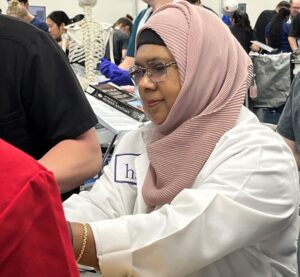Rehana Lovely
.Rehana S. Lovely, Ph.D.Assistant Professor .Ph.D. Yamagata University, Japan |
|
Teaching
At UNT Health Science Center I serve as the course director for our large gross anatomy course for Masters of Medical Science students (SARS 5401). I also I teach dissection-based anatomy to first year osteopathic medical students and prosection-based anatomy courses to physical therapy and physician assistant students.
Courses Taught
- SARS 5401: Structural Anatomy (graduate students)
- MEDE 7811: Musculoskeletal and Skin Systems 1 (medical students).
- MEDE 7812: Nervous System 1 (medical students).
- MEDE 7615: Cardiopulmonary System 1 (medical students).
- MEDE 7611: Gastrointestinal & Renal Systems 1 (medical students).
- MEDE 7715: Reproductive & Endocrine Systems 1 (medical students).
- DPHT 7200 & 7400: Clinical Anatomy 1 & 2 (physical therapy students).
- MPAS 5401 & 5208: Clinical Anatomy 1 & 2 (physician assistant students).
.
Outreach
I am involved in the many K-12 outreach programs run by Center for Anatomical Sciences at UNTHSC. Our programs, such as Mentors for Life, the Texas Academy of Biomedical Sciences (TABS) Summer Bridge Program, and JAMP summer programs, expose students to science and medicine as potential future career choices.
.
Research
My research investigates the role of the gamma component of fibrinogen in the formation of blot clots with an emphasis on environmental and genetic factors influencing fibrinogen-related cardiovascular disease.
.
Selected Publications
- Lovely RS, Hossain J, Ramsey JP, Komakula V, George D, Farrell DH, Balagopal PB. 2013. Obesity-Related Increased γ′ Fibrinogen Concentration in Children and Its Reduction by a Physical Activity-Based Lifestyle Intervention: A Randomized Controlled Study. The Journal of Pediatrics. 163(2):333-8.
- Lovely RS, Yang Q, Massaro JM, Wang J, D’Agostino RB, O’Donnell CJ, Shannon J, Farrell DH. 2011. Assessment of genetic determinants of the association of γ′ fibrinogen in relation to cardiovascular disease. Arteriosclerosis, Thrombosis, and Vascular Biology. 31(10):2345-52.
- Lovely RS, Kazmierczak SC, Massaro JM, D’Agostino RB, O’Donnell CJ, Farrell DH. 2010. γ′ fibrinogen: evaluation of a new assay for study of associations with cardiovascular disease. Clinical Chemistry. 56(5):781-8.
- Flood VH, Al-Mondhiry HA, Rein CM, Alexander KS, Lovely RS, Shackleton KM, David LL, Farrell DH. 2008. Fibrinogen Hershey IV: a novel dysfibrinogen with a γ V411I mutation in the integrin αIIbβ3 binding site. Thrombosis and Haemostasis. 99(6):1008.
- Mannila MN, Lovely RS, Kazmierczak SC, Eriksson P, Samnegård A, Farrell DH, Hamsten A, Silveira A. 2007. Elevated plasma fibrinogen γ′ concentration is associated with myocardial infarction: effects of variation in fibrinogen genes and environmental factors. Journal of Thrombosis and Haemostasis. 5(4):766-73.
- Lovely RS, Moaddel M, Farrell DH. Fibrinogen γ′ chain binds thrombin exosite II. 2003. Journal of Thrombosis and Haemostasis. 1(1):124-31.
- Lovely RS, Falls LA, Al-Mondhiry HA, Chambers CE, Sexton GJ, Ni H, Farrell DH. Association of γA/γ’fibrinogen levels and coronary artery disease. 2002. Thrombosis and haemostasis. ;88(1): 26-31.


Social media